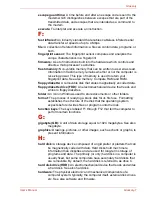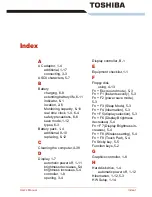
User’s Manual
Glossary-9
Glossary
L2 cache:
Memory cache installed on the motherboard to help improve
processing speed. It is slower than L1 cache and faster than main
memory. See also cache memory, L1 cache.
LAN:
A group of computers or other devices dispersed over a relatively
limited area and connected by a communications link that enables
any device to interact with any other on the network.
Light Emitting Diode (LED):
A semiconductor device that emits light when
a current is applied.
Liquid Crystal Display (LCD):
Liquid crystal sealed between two sheets of
glass coated with transparent conducting material. The viewing-side
coating is etched into character forming segments with leads that
extend to the edge of the glass. Applying a voltage between the
glass sheets.
M:
main board:
See motherboard.
megabyte (MB):
A unit of data storage equal to 1024 kilobytes. See also
kilobyte.
megahertz:
A unit of wave frequency that equals 1 million cycles per
second. See also hertz.
memory:
Typically refers to the computer’s main memory, where programs
are run and data is temporarily stored and processed. Memory can
be volatile and hold data temporarily, such as RAM, or it can be
nonvolatile and hold data permanently, such as ROM. A computer’s
main memory is RAM. See RAM, ROM.
menu:
A software interface that displays a list of options on the screen.
Also called a screen.
microprocessor:
A hardware component contained in a single integrated
circuit that carries out instructions. Also called the central
processing unit (CPU), one of the main parts of the computer.
mode:
A method of operation, for example, the Boot Mode, Sleep Mode or
the Hibernation Mode.
modem:
Derived from modulator/demodulator, a device that converts
(modulates) digital data for transmission over telephone lines and
then converts modulated data (demodulates) to digital format where
received.
monitor:
A device that uses rows and columns of pixels to display
alphanumeric characters or graphic images. See also CRT.
motherboard:
A name sometimes used to refer to the main printed circuit
board in processing equipment. It usually contains integrated
circuits that perform the processor’s basic functions and provides
connectors for adding other boards that perform special functions.
N:
network:
A collection of computers and associated devices that are
connected by communications facilities. A network allows you to
share data and peripheral devices, such as printers, with other
users and to exchange electronic mail.
Summary of Contents for SATELLITE L310
Page 1: ...TOSHIBA Satellite M300 L310 Satellite Pro M300 L310 Portable Personal Computer User s Manual ...
Page 34: ...xxxiv User s Manual Preface ...
Page 52: ...1 18 User s Manual Introduction ...
Page 74: ...2 22 User s Manual The Grand Tour ...
Page 134: ...5 8 User s Manual The Keyboard ...
Page 152: ...7 4 User s Manual HW Setup ...
Page 190: ...9 24 User s Manual Troubleshooting ...
Page 194: ...A 4 User s Manual Specifications ...
Page 200: ...C 4 User s Manual Wireless LAN ...
Page 220: ...Glossary 14 User s Manual Glossary ...
Page 224: ...Index 4 User s Manual Index ...










































